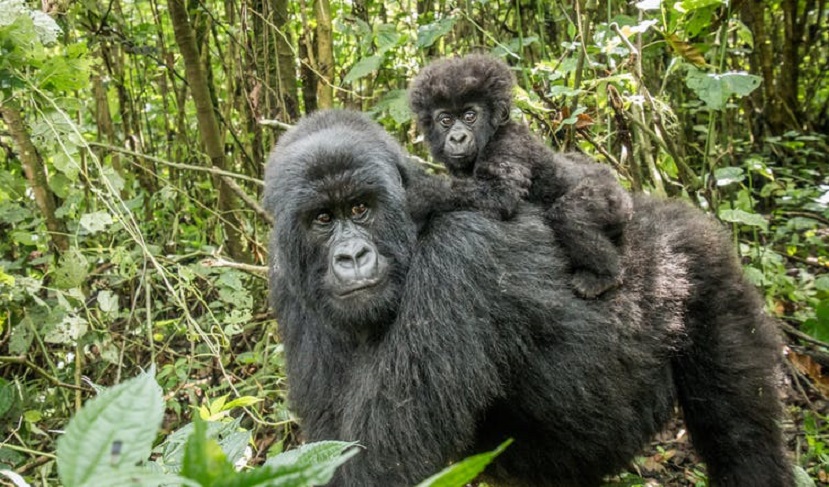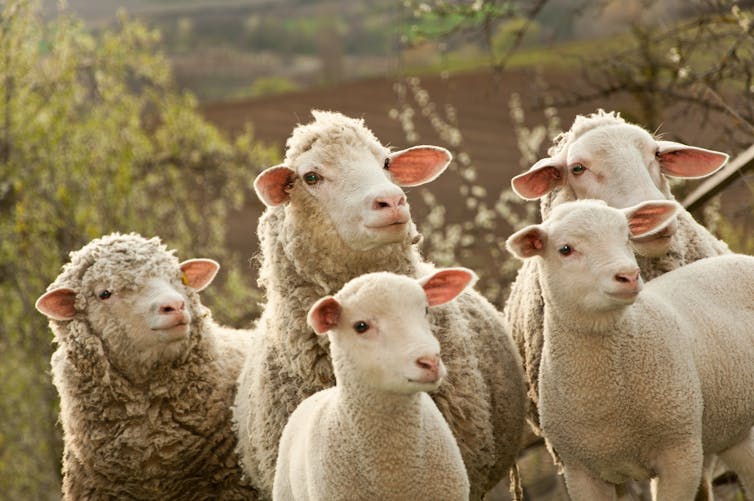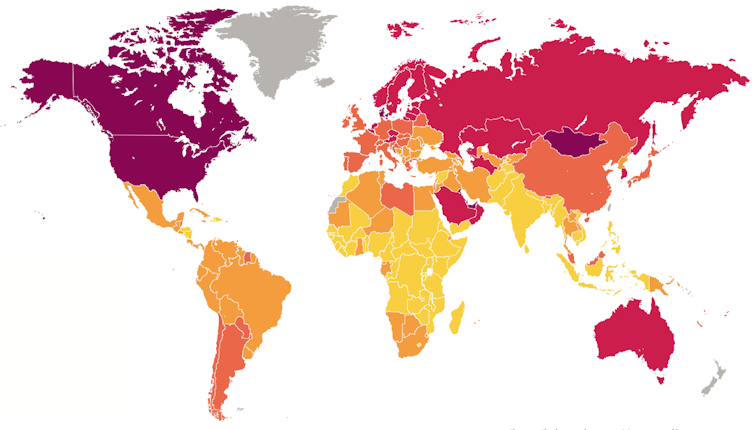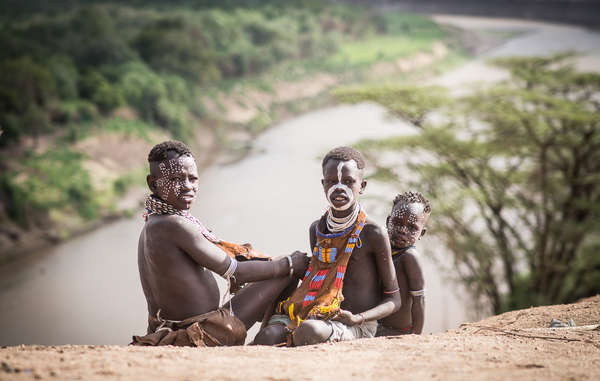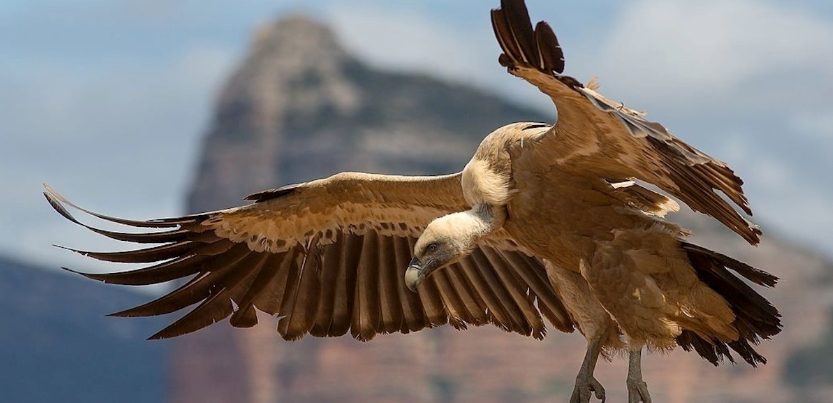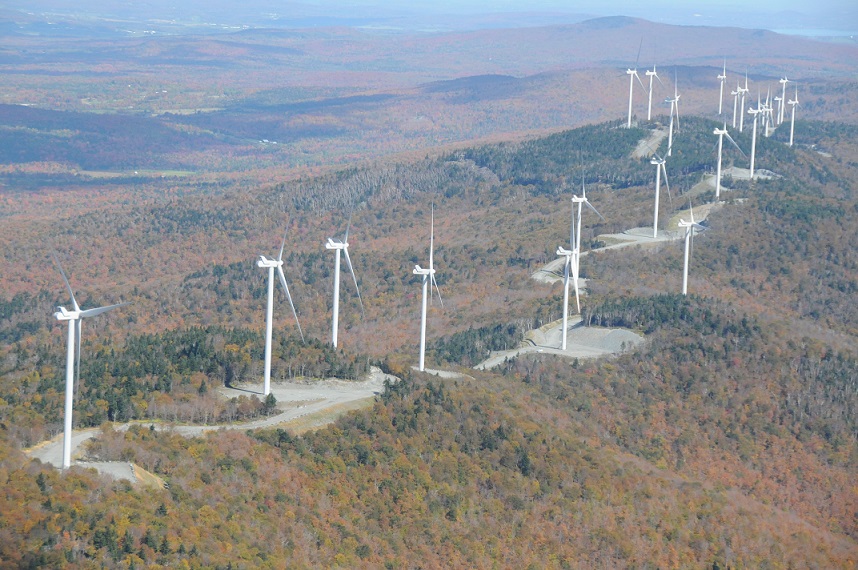Ogiek Want Their Mau Forest Back
By Kennedy Gachuhi – originally published 07. Feb 2019 on https://ecoterra.info
Ogiek stake claim for the Mau forest after victory at African court
The Ogiek have demanded the return of the Mau forest land to the community.
The community is laying claim to more than 21 forest blocs and the Maasai Mau Trust Land that makes up the Mau Complex saying it is their ancestral land.
The demands were tabled yesterday in Nakuru when representatives of the community met a taskforce on the implementation of the African Court’s ruling on the Ogiek land rights in the Mau forest.

Members of the Ogiek community during a meeting when they presented their memorandum on February 6, 2019 to the members of the task force on implementation of the African Court’s decision on the Ogiek community’s land rights in the Mau forest issued against the government of Kenya in 2017. [Photo: Harun Wathari]
In May 2017, the African Court ruled that the Government had infringed on the Ogiek community rights. The Arusha-based court ruled that the Mau had been part of the community’s ancestral land for decades.
The ruling arose from a case filed in 2006, in which the Ogiek complained that Kenya Forest Service (KFS) officials issued them with notices to vacate the forest without factoring in how this would affect their lives.
Follow-up
In a follow up to the ruling, the Ogiek People’s Development Programme Executive Director Daniel Kobei yesterday tabled a 13-point memorandum.
Top on the list of the memoranda is that the Mau forest ownership be returned to the community for safekeeping.
“We wish to remain the custodians of the land and forest. With the help of the Government, we will see to it that all misery and degradation of forested homelands are restored,” said Kobei.
The Ogiek are seeking community land titles which shall not be alienable in future.
“Member households will have rights for house and farm plots in perpetuity but any transfer shall be done to their fellow members of the Ogiek community,” he said.
The community proposed that the habitation within the forest shall be limited to areas agreed upon with the Kenya Forest Service and other agencies and grazing restricted to naturally unforested zones or as advised by the government.
It also wants a sharing agreement for all revenue generated from the Mau and compensation for loss of property, development and freedom to exercise its culture.
MEMORANDUM FROM THE OGIEK COMMUNITY
Presented on 6 th February 2019, Nakuru Town, Kenya
TO:
THE TASKFORCE ON THE IMPLEMENTATION OF THE DECISION OF THE AFRICAN COURT ON HUMAN AND PEOPLES’ RIGHTS ISSUED AGAINST THE GOVERNMENT OF KENYA IN RESPECT OF THE RIGHTS OF THE OGIEK COMMUNITY OF MAU AND ENHANCING THE PARTICIPATION OF INDIGENOUS COMMUNITIES IN THE SUSTAINABLE MANAGEMENT OF FORESTS

Dr. Robert Kibugi – Chairperson
Dr. Sally Kimosop – Vice Chairperson
Ole Kamuaro Olottisatti Nabulu – Member
Malik Aman Abdi – Member
Stephen King’uyu – Member
Esau Oginga Omollo – Member
Cyrus Mutuku Maweu – Member
Eugene N. Lawi – Member
Alfred Mumpasoi Keriolale – Member
Emmanuel Bitta – Member
Belinda Okello – Member
Tom Abuta – Member
IN RESPECT OF THEIR INALIENABLE RIGHTS TO DIGNITY, SURVIVAL, AND WELL BEING
Preamble
Considering that, in accordance with the principles proclaimed in the Charter of the United Nations, recognition of the inherent dignity and of the equal and inalienable rights of all, is the foundation of freedom, justice and peace.
Recognizing, the urgent need to respect and promote the inherent rights of Indigenous peoples which derive from their political, economic and social structures and from their cultures, spiritual traditions, histories and philosophies, especially their rights to their lands, territories and resources.(UNDRIP) Article 10 of UNDRIP, Indigenous peoples shall not be forcibly removed from their lands and territories. No relocation shall take place without the free, prior informed consent of the indigenous peoples concerned and after agreement on just and fair compensation, and where possible , with the option of return.
Inspired by the provisions of Article 1.1 of the Declaration of the Rights of Persons belonging to National or Ethnic, Religious and Linguistic Minorities; which states that ‘States shall protect the existence and the national or ethnic, cultural, religious, and linguistic identity of minorities within their respective territories shall encourage conditions for the promotion of their identity.
It is our hope that the Taskforce on the implementation of the Decision of the African Court on Human and Peoples’ Rights issued against the Government of Kenya in Respect of the Rights of the Ogiek Community of Mau Complex and enhancing the participation of indigenous communities in the sustainable management of forests which was appointed by the Cabinet Secretary for Environment and Forestry Vide Gazette Notice No. 11215 of 2018, shall endeavour to take constructive and decisive steps to fulfilling their Terms of Reference, which includes a review of the decision of the African Court on Human and Peoples’ Rights issued against the Government of Kenya in respect of the rights of the Ogiek Community of Mau and any other judgements issued by domestic courts in relation to the Ogiek Community’s occupation of the Mau Forest.
Further, we call on the government to speed up the implementation by remedying all the violations meted on the Ogiek people as identified by the African Court decisions i.e. the violations of articles 1, 2, 4, 8, 14, 17, 21, and 22 of the African Charter while honouring the decision of the African Court on Human and Peoples’ Rights which is one of the guiding principle in addressing the land claims of the Ogiek community.
Specifically, through this Task force, we call on the Government of Kenya to recognize of our right to live in the Mau Forest as our ancestral land in accordance with the Constitution of Kenya (Article 63 (2) (d) (ii)), and on conservation conditions to be agreed. The objective is to save our lands, our culture and our forests.
The Ogiek of Mau
We, the undersigned are all members of the Mau Ogiek community of approximately 45,000 members, historically and presently living in and around the Mau Forest Complex in central Rift Valley. We have consulted with the Mau Ogiek people and the submission made here is made of and on behalf of all Mau Ogiek.
We are closely related to our brothers Ogiek living historically and presently on Mount Elgon. They face the same problems of having their lands wrongfully taken as government then made public lands, set aside for so-called forest protection. Our forests have not been protected and our lives have been almost destroyed. We have always known and still know that the key to our survival and contributions as all Kenyans as forest protectors is recognition of our rightful ownership of our forested territories. We welcomed the Constitution of Kenya in 2010 with relief and tears because it provided for this. Government’s failure to deliver on Article 63 (2) (d) (ii) is an abuse of the Constitution and all the human, development, and other modern rights it pledges for all Kenyans.
The Mau Ogiek are concentrated mainly, but not solely, in the following areas:
1. Eastern Mau: Nessuit location, Mariashoni location, Sururu, Eburu, Ndoswa, Bararget, Kiptunga, Tertit
2. South western Mau: Kiptororo, Tinet area and Saino
3. Narok: Sasimwani, Olopirik, Ol Posumoru, Enaibelbel, Sogoo, Nkaroni, Nkareta, Olmekenyu, Ololoipangi, Enoosupukia, Lemek, Kuto.
4. Uasin-Gishu: Kipkurere, Ndungulu
5. Nandi: Cerengonik, Kosabei/Koigener
6. Kericho: Sorget, Tendeno, Maasaita,
7. Baringo: Koibatek, Maji Mazuri area
8. The remainder of the Ogiek people mainly live in the forested areas of Mount Elgon, at Chepkitale.
The Ogiek of Mt. Elgon will make their own submissions to the Task Force as will other indigenous forest peoples: the Sengwer, Yiaku, Watha and Aweer. We have all suffered the same ill-treatment of our land and human rights during the 20 th century.
We have been subjected to numerous violations of our rights to our land and resources stemming from colonial times. We have been displaced, disposed and evicted numerously from our ancestral lands after extensive de-gazettement of our forest land in Mau and elsewhere by the government through protectionist policies with camouflage of conservation that do not recognize our historical claims to forest areas, being our ancestral land. The African Court ruling recognized the Mau as our ancestral lands. Our primary concern is to see this delivered.
Summary of Human and Land Rights issues experienced by the Ogiek
i. Land tenure issues: – Lack of land tenure has made the Ogiek vulnerable to land loss through evictions, dispossession and displacements. The land loss has been occasioned by irregular excision and allocations that took place in the Ogiek land in Mau and are aggravated by perennial evictions. Further, corruption and fake land documents or title deeds have catalyzed dispossessions of Ogiek land through numerous court cases. Illegal titles have become a source of conflict with corruptions draining the community of resources spent in litigation while making the community poorer by day. To end this the entire Ogiek land must be restored to us through revocation and cancellation of all title deeds.
ii. Recognition of the Ogiek Community as a distinct separate people. The Kenyan constitution and the reports from the Ministry of Home Affairs indicate that there are 43 ethnicities in Kenya. Like other hunter gatherer communities in Kenya, the Ogiek are not included in that number. This is contrary to international standards on recognition of indigenous peoples, especially since the Ogiek meet both the objective and subjective criteria of any existing definition. Though the current constitution refers to the Ogiek as a minority community or marginalized group, we are yet to witness meaningful impact of this recognition.
iii. Some laws and policies have criminalized Ogiek culture. Between 1930 and 1935, a Carter Land Commission constituted by the British Colonial government recommended that the Ogiek and other hunter gatherer groups be assimilated into the communities they neighbour. Subsequent wildlife and forest laws outlawed hunting and gathering thus effectively criminalizing the Ogiek hunting and gathering cultures. New laws e.g. the Forest Act 2005 and Forest Conservation and Management Act 2016, do not also cater for the interests of hunter gatherer communities as primary rights holders to their forest lands. The last law does allow for community forests on community land, but first we need recognition that these are our lands. These laws provide only for forest people to register as Community Forest Associations (CFAs) and enter into management agreements with the government before they can be given the right to help Government protect forest lands. This fundamentally denies the inherent existence of communities for who such forests have always been their homes, and makes their continued existence dependent on state recognition. It has further eroded Ogiek traditional rights by introducing user charges, privileging the emergence of competing interests and resulting in massive loss of forest.
iv. Logging and other illegal activities in the Mau forest constitute the biggest threat to Ogiek cultures, religious and livelihoods. The licensed and unlicensed logging activities not only also threaten the biodiversity of the forest but are leading to the rapid drying up of rivers a e.g. Lake Nakuru, Elementaita and Naivasha. The Mara River that sustains the Maasai Mara Game Reserve – one of the Seven Wonders of the World is also threatened. We would not allow logging and other illegal activities if our lands were recognized as our property.
v. Frequent arrests and intimidation of Ogiek leaders and community members is also a major problem. Many Ogiek are facing land related cases in Court in spite of the court rulings that protects them, more specifically those residing in Mariashoni and Ngongongeri (Esingetit). There has been selective and malicious prosecution of Ogiek community. Some of the community members having sentence to life imprisonment due to land related matters.
vi. Fruitless government engagement and consultation with the Ogiek:
The Ogiek have, on numerous occasions, engaged the government in negotiations and approached the Kenyan courts to seek justice. However, for reasons not well known to them, none of their cases have been successful prosecuted and on the rare occasions when decisions have been in their favour, they have not been fully implemented. Besides the legal redress mechanisms, the Ogiek have also engaged the government in abide to resolve land grievances on the following instances:-
a) During 2009/2010 the Hassan Noor led Interim Coordinating Secretariat to the Mau Task Force Report
b) 2014/15 engagement with the Ministry of Environment and Natural resources led by then Permanent secretary in the Ministry Dr.Richard Lesiyampei
c) And recently (2015/16) the engagement with the National Lands Commission led by Prof. M. Swazuri
Worth noting is the several past attempt by the government to address the Ogiek issues through task forces, commissions and committees but which after their term ends there has been no positive change but rather perpetuation of the vice against the Ogiek peoples. Government has been consistently not serious in both recognizing our land rights and seeing this as the best means through which the tragically degraded Mau forests can be saved. It has been advised many times that this is practical and right including by these projects and documents; the Kenya Indigenous Forest Conservation (KIFCON-1991 to 1994), the Njonjo Commission of Inquiry 1999, the Ndung’u Commission 2002, the Truth Justice and Reconciliation Commission 2012, the Mau Task 2009.
We respectfully ask this Task Force to advise Government to end this tragedy, for the sake of our rights and for the sake of forest conservation.
These are our submissions:
1. We demand restitution of our ancestral lands which extend over much of the Rift Valley comprising the 21 Government Forests blocks and the Maasai Mau Trust Land Forest that make up the Mau Complex. These includes lands lost through land grab and other irregular and corrupt schemes e.g. Farms of Ngongongeri, Likia, Teret.
2. We want these forests returned to our ownership and fully accept that this transfer must be made on these conditions:
a. That Ogiek are not ready for commercialization of their rights. As such we remain custodians of our land and forest and would never agree to sell these lands. Our precious forests, also sources of Kenya’s most precious water towers ARE NOT FOR SALE. Our descendants will hold these lands in posterity in the same way as our forefathers did, and as we expect to be formalized today.
b. We will keep these forestlands for time immemorial as forests safeguarding them against encroachment, exploitation and dilapidation.
c. We will, with Government help, see that all the misery and degradation of our forested homelands are restored as far as possible to their former glory. WE WANT OUR HOMELAND BACK AND ITS CONDITION.
d. We want the government to recognize the Ogiek as a people with unique interaction with the nature by recognizing Ogiek special cultural zones and erecting a monument for the Ogiek in Mau forest.
3. We have a strong will to do this and in doing so we safeguard national Kenyan interests in ensuring that the forests are restored to their former condition. We submit that it is of direct importance for us more than for other Kenyans, that the Mau is rehabilitated. This is because forests are the foundation of our livelihood and culture. Our society will die without the forests. We have been fighting against that for many years and no matter what happens, we will keep fighting for our cultural survival.
4. We want Mau returned to us as our communal land. This is how we lived in and kept the forests in good condition, because we were spread out by clans.
5. The resources accruing from the natural resources of Mau shall have benefit sharing arrangement. These would include and not limited to forest products but also the waters of Mau flowing to various parts Kenya.
6. Compensation of the Ogiek for all damages suffered as a result of the violations, including the payment of pecuniary damages to reflect the loss of their property, development and natural resources, the payment of non-pecuniary damages, to include the loss of their freedom to practise their religion and culture, the establishment of a community development fund for the benefit of the Ogiek, the payment of royalties from existing economic activities in the Mau Forest, and ensuring that the Ogiek benefit from any employment opportunities within the Mau;
7. We seek formal entitlements reflecting our ancient territorial arrangements and which are still practical today. We expect entitlement in the form of Community Land Titles. Each territory will be known as Ogiek op Nessuit Community Land, Mariashoni Community Land, Sasimwani Community Land, and so on. This ownership will never be alienable. This may be inscribed on our title deeds.
8. The Constitution of Kenya 2010, recognizes that we are community landholders and that we are eligible for issue of formal title (Article 63 (2) (d) (ii). The Land Act, 2012 protects customary land ownership as equally important as private ownership (section 5). The Community Land Act, 2016 was enacted to enable all communities to identify and secure their lands under titles. We urge all possible action to see the Community Land act 2016 is operationalized including in our regard. This will also mean we can declare Community Forests on our lands (see below).
9. Member households of each community landowner will have rights. They will be issued usufruct entitlements for house and farm plots in perpetuity. They will be permitted to transfer these entitlements to other members of the community or to other Ogiek and outsiders through a procedure that each community will individually decide upon. Ultimate title to these parcels will remain with the community. This is also what the Community Land Act provides for.
10. We want our indigenous knowledge and innovations contributing to conservation of Mau forest biodiversity is recognized and valued. Ogiek are protectors of bees and birds which are pollinators of our crops and plants which contribute to food sovereignty. It is worth noting that the Ogiek community in conjunction with KFS and other stakeholders have rehabilitated over 100 acres of indigenous trees and 25 community scouts have volunteered to protect the forest as show case of our potentiality.
11. Habitation within each zone will be limited to areas which we agree with Kenya Forestry Service or other appropriate agencies. These will include areas that are naturally unforested and lands in and around present Forest Stations. Grazing will be restricted to zones that are naturally unforested (glades and moorlands), again in agreement with our technical adviser, the Kenya Forest Service.
12. Each community will also define Community Forest Reserves. In most cases we believe this will fall into two categories: Community Protected Forests and Community Use Forests. Different rules will apply. In neither case will any habitation or farming be permitted.
13. a) We understand that responsibilities go with rights. We look forward to becoming the rehabilitators and conservators of the Mau Complex in service for the nation. We look forward to working with the Ministry of Environment and all its agencies towards saving the Mau, and saving our society. We need and want their advice to help us do the very best job.
13. b) We make a prayer to the Task Force on the implementation of the decision of the African Court on Human and Peoples’ Rights issued against the government of Kenya in respect to the Ogiek Community of Mau to address our shared land and forest rights as a priority for action. We acknowledge that it is not practical to return land to all aggrieved people of Kenya. But the case of traditional forest dwellers is straightforward and special. We have been waiting for recognition of our homeland forests for over 100 years. We know that without return of our forestlands, we cannot survive. We also know that without restoration of our land rights the Mau will slowly but surely disappear.
14. We also demand that while all the above is being delivered that we, the rightful owners of the Mau Forests will not be evicted from our homeland.
It’s worthy noting that the Ogiek are an important part of Kenyan history and heritage. Protecting our culture and guaranteeing our survival is an inherent duty of the State. In the face of wrongdoing, as found conclusively by the African Court on Human and Peoples’ Rights, it is the obligation of the State to take the necessary steps to restore our dignity and worth, and we call upon the Task Force to work to urgently implement this path-breaking judgment.
We wish to implore to the Taskforce to consider Ogiek Peoples Development Program (OPDP) for any form of consultation on behalf the Ogiek Community of Mau, as the case was with ACHPR. It will ease and deter masqueraders from intruding to the Task Force.
This memorandum is an addendum to the judgment of the African Court on Human and Peoples’ Rights and formal submission we have made to the Court since at is request. This submission is consistent with that submission held by the Court. It does not supersede the wishes of the Ogiek community and the ruling of the Court.
6 th February 2019, Nakuru Town, Kenya
Signed by 71 Ogiek Elders
—
“At the moment we cannot say we have much for public consumption but by May we shall have our report and submit to the CS,” the task force chair Dr. Robert Kibugi said after visiting various forest blocks of the Mau.
The meeting was also attended by Kuresoi South MP Joseph Tonui and nominated Senator Victor Prengei.
The African Union landmark ruling was delivered already on May 26, 2017 and Kenya is in delay to follow the verdict and implement the remedies.
The Court found that the Kenyan government violated various rights of Ogiek by evicting them from their ancestral land in Mau Forest.
The court ordered the Kenyan government to take all appropriate measures within a reasonable time frame to remedy all the violations committed against the Ogiek.

